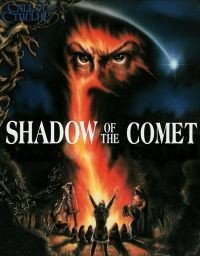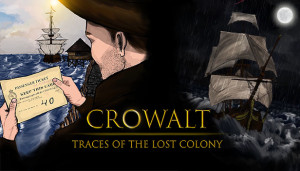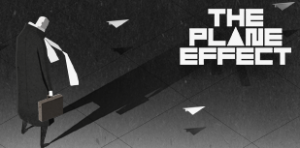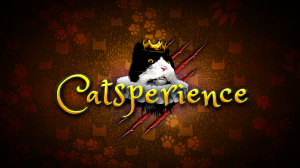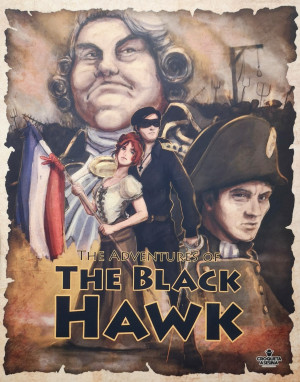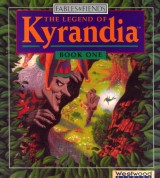Call of Cthulhu: Shadow of the Comet flashback review
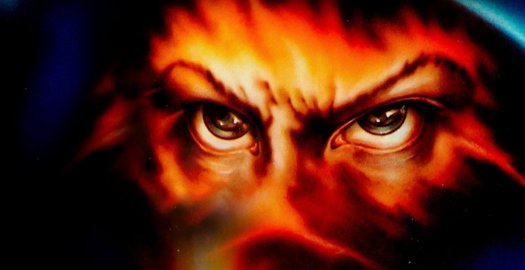
Way back in our February 2004 review, we declared Call of Cthulhu: Shadow of the Comet to be, ‘the greatest horror adventure game ever created’. Two decades on from this, how does Infogrames’ 1993 Lovecraftian point-and-click hold up?
It seems to me that over the past ten years or so the horror genre in general has seen something of a renaissance take place. In films, television, books and more recently podcasts, the number and quality of available offerings has steadily risen to the point that we are now completely spoiled for choice in those darker winter months. Whatever the reason for this, nowhere has this increase been more apparent than in computer gaming, where modern console-based horror games are now amongst the most numerous and popular.
Back in the early 1990s, choice in computer game scares was quite a lot more limited, to say the least. Horror games of any type were a comparative rarity, and in the adventure genre even more so. Infocom’s 1987 The Lurking Horror text adventure springs immediately to mind, and maybe Sierra’s 1992 The Dagger of Amon Ra. There were undoubtedly others too, but of any significance? Games like I Have No Mouth and I Must Scream and Sanitarium were still to come. In France however, a young group of programmers heavily inspired by the cult writings of Howard Phillips Lovecraft, decided to attempt to create an ambitious and shocking adventure game to blow the likes of Sierra’s Laura Bow right out of the (dark and foreboding) water.
Let’s be clear upfront that Call of Cthulhu: Shadow of the Comet was, in its day, not quite the revelation that Infogrames had been hoping for. The reviews were mixed. Everyone had been impressed with Infograme’s own survival horror game Alone in the Dark of the previous year. So when this ‘old fashioned’ (according to Computer Gaming World magazine, August 1993) horror adventure game appeared people were a little perplexed.
What they did praise, however, was the well-written plot. And that’s probably also the reason this game still made it onto the Adventure Gamer’s Top 100 All-Time Adventure Games in 2011, at no. 76. We said, ‘If you're looking for an adventure capable of keeping you on the edge of your seat and then making you jump from it, you still can't go wrong with Shadow of the Comet, even to this day.’ That was true in 2011; is it still true in 2024?
Let’s approach the game from the point of view of a new player loading it for the first time. The lengthy opening sequence which serves to introduce us to the main character, astronomer-photographer-journalist John Parker, as well as the initial subject of his investigation, a man named Lord Boleskine, is certainly impressive for 1993. It’s a colourful and atmospheric bit of animation that lasts for several minutes.
In brief, the story is that Parker has talked his way into receiving financing for passage across the Atlantic to America from Britain, courtesy of the British Scientific News journal. As it is 1910, he’ll presumably be travelling by ocean liner. His aim once there will be to photograph Halley’s Comet, as well as to investigate Lord Boleskine’s journals and the town of Illsmouth. Boleskine was apparently driven crazy by events which he himself uncovered in the town 76 years prior, whilst observing the comet there (Halley’s Comet — a real comet — is visible from Earth approximately every 76 years, hence the time frames).
Watching the intro however, two things irritated me a little. Firstly, although the title of the story is Shadow of the Comet, the thing in the title sequence that goes whizzing past like a jet fighter is a meteor, not a comet. A comet travels around the sun in space, and it is so far away its position in the sky appears to change only very slightly as the nights pass. Maybe the game makers knew this and just decided to take some artistic licence for the sake of drama.
Secondly, the pacing of the action sequences combined with the voices and the subtitles is completely off, due to long pauses in the presentation. People stop speaking suddenly, then continue where they left off 10 seconds later. This makes it tricky to follow what is going on, and unfortunately it’s a theme throughout the entire game. It could be a sign of the game engine struggling under the weight of the ambition of the content. It does end up hindering things such as comprehension and character movement later on in the game.
One of the nicer presentation features is the use of full screen portraits of characters when they are speaking. On the downside, these portraits bear absolutely no resemblance to their smaller animated sprite counterparts, which can make it hard to tell who is talking when there are more than a few characters on the screen. However, if you are familiar with horror films from the 1960s, it immediately strikes you that Parker’s landlord for the duration of his stay, Dr Cobble, seems to be played by Vincent Price, the famous American actor! As the game progresses you’ll also find star turns by Jack Nicholson, Sean Connery and even H.P. Lovecraft himself. It’s quite amusing and was probably done to lend extra gravitas to the characters and the story; it really works! I’m not sure programmers could get away with borrowing uncredited likenesses these days.
Moving past the intro into the game itself, our first view of Illsmouth is the harbour where Mr Parker is awaited by Dr Cobble, along with the Mayor of Illsmouth. Following a short, stilted conversation with way too much eye blinking, you make your way by horse-drawn carriage to your accommodation.
Once you gain full control of Mr. Parker, another of the game’s (many) Achilles' heels starts playing up. The control system is a level or two worse than the awful controls found in Sierra’s first Space Quest game. You actually have to hold the mouse button down to trundle Parker along in the chosen direction. Fortunately there is a partial work-around — you can use the keyboard instead of the mouse. The arrow keys control Parker, with other keys used for the usual adventure game commands. For reference, the game and its manual, can now be found on archive.org.
Although the keyboard control is preferable, Parker still continually gets trapped behind random pieces of scenery and invisible changes in his allowed screen path. Equally frustrating are the object interactions, whereby you somehow need to ‘see’ an object (indicated by a dotted eyeline appearing between Parker’s head and the object in question), examine it, and then ‘unsee it’ before being able to interact further with the object. It’s a constant hassle, but you somehow get used to it.
Once you manage to steer Parker out of the house and into town you can begin to enjoy the game a little more with a bit of sight-seeing. The background graphics really are very nice, being highly colourful and detailed. Architecturally, the town of Illsmouth varies broadly between American shingle homes, some of them very grand indeed, broken down sheds and ramshackle cottages. It seems to be a pleasant place on the surface, but the people sure are a suspicious bunch, which is at least partly why we are here!
Without wishing to walk through too much of the story, it doesn’t take long before Parker finds himself in the town records office. Here he falls under the suspicious eye of Tobias Jugg, the man in charge of the local archives. This is where our quest begins in earnest. From here on, the clues start to stack up and the scale of the challenge Parker has let himself in for becomes clear. There are many locations that can be accessed right away, many characters to meet — most of whom you will forget instantly — and many tasks to be undertaken.
To be frank, it’s all a little overwhelming. In earlier times, developers sometimes felt that a long gameplaying experience could be equated with a feeling of receiving value for money. However, limited storage space on disc-based media often meant that certain puzzles had to be fiendishly difficult in order to stretch the playing time out with some prolonged head-scratching. This is understandable, but Shadow of the Comet is far from a short game — which is part of what is impressive about it — and the difficulty level rises too quickly.
From the outset, Parker is required to find all kinds of strange items hidden in random places, some of which will not reveal themselves until slightly later in the story. For example, there are items hidden in Jugg’s house (to which it is fairly easy to gain access early on) that do not reveal themselves until certain other objects have been found. With so many locations to explore, it could be quite some time before you think of returning to the cubby hole where you had already found one solitary item. Maybe Jugg could have been moving his things around? Argh!
So this is not a game for the incurious. You really need to have a determined mindset to progress very far, without using a walkthrough. And when you do use the walkthrough, you must be prepared to steel yourself against using it continually because of the illogical nature of some of the solutions. Indeed, reviewers at the time were keen to point out just how hard it is to get through certain puzzles. To make matters worse, there are a couple of mazes to contend with, which are certainly out of fashion in the genre.
There are no time-based puzzles, so you are not liable to miss something through inaction, although there are several lengthy action sequences during which you have to run Parker away from danger through a maze-like sequence of screens. Use of the keyboard is essential here. I actually quite enjoyed these scenes, but for purists they may come as a bit of a shock. Even though adventure games are now more likely to include more than one style of gameplay in a single game, a mixture of puzzles with heart-pounding action sequences was never a popular combination; not in point-and-click adventures anyway.
What these action sequences do bring to the game are some supernatural scares. The game has several moments of critical activity that build up very slowly, but it would be a stretch to call much of it in any way ‘scary’. That is, until Parker is haring along a dimly lit tunnel with a gigantic slug-like creature hot on his heels. These scenes do get the pulse racing in what is otherwise a sedate puzzle grind-athon. That said, they’re probably not going to elicit more than a raised eyebrow from players more accustomed to scares in more modern games, such as Amnesia.
There is a contradiction in these action sequences, too. Parker has a heart condition which leaves him unconscious after a fright on the first night. By the third night, however, he is racing around in darkened tunnels, springing lithely past monsters so terrifying that just to look at them would instill madness, his heart condition a distant memory. He’s also happy to wade in and take on a group of street thugs in a fight, easily beating them.
What does make sense are the many, many, MANY accidental deaths that Parker will experience. Each time you come to a sticky end, you have to listen to the dulcet tones of protagonist Jonas Hambleton slowly reciting the line, 'Poor Parker, so young and already in the next world!' In fact, even when Parker has not died but has just been arrested, for example — as can happen — Hambleton still says the same thing. You’ll hear this phrase so often that it will come as a relief when you eventually realise you can skip it by pressing the 'load game' key. Oh, and make sure to save often!
Speaking of voices, the voice acting is one of the better reasons to at least give Shadow of the Comet a go. It’s not so much for the quality as for the sheer exuberance of some of the voice talent on show. John Parker himself, voiced by a British-sounding actor of Shakespearean grandeur, is at times so over the top that he almost makes you forget you’re not at the theatre but are in fact playing a computer game. It’s an incredibly robust performance. That this actor’s work went uncredited shows you how little regard was given to the computer game medium at the time.
For some characters, conversely, the quality dips so low it can become painfully funny. Lord Boleskine’s deep Scottish tones, for example, are supposed to be ghostly and aloof but unfortunately just sound very silly. It’s fair to say that a lot of progress has been made in recent years concerning consistency in voice acting, especially since Grim Fandango showed everyone how to do it properly.
Further to the voice acting, the music is in the classic, early 90s Ad-lib style. Although it is suitably eerie and lends some gravitas to the proceedings, it twangs away unremittingly in the background and is not particularly memorable.
One final problem with Shadow of the Comet is story coherence. A lot has been made about the story, or the narrative, being of a quality that is high enough to overcome many of its shortcomings. This is and isn’t true. Whilst the investigation builds satisfyingly at times through the puzzle solving, if you look at the different story elements, many of them don’t really connect sensibly to create a coherent narrative.
Take for example the lighthouse scene. Parker spends quite some time solving puzzles in order to gain access to the lighthouse, which is supposedly an important location. Once you figure out how to prevent Parker from being killed and actually get past the lighthouse gate, you spend about 30 seconds climbing the outside of the thing before jumping straight off again and landing by mistake in the forest. You never have to go back to the lighthouse again.
At one stage Parker is transformed into a bird — yes, a bird — without any kind of precedent, in order to reach a special location. At other times he has to rely on plain old boats and sewer-crawling in order to reach certain places.
Add in the aforementioned contradictions about Parker’s health problems, together with a fairly mundane final sequence involving the comet tail and seemingly random placement of jewels in order to do something mystical, not to mention one of the cheesiest and most out-of-place endings in adventure gaming, and it all feels a bit disjointed and anticlimactic. Adventure game stories are often silly and inconsistent, but I’m not sure H.P. Lovecraft would have sanctioned this kind of thing.
There are those who absolutely adore Shadow of the Comet, and it is possible to see why, but for me it’s a piece of gaming history that is probably best experienced by watching a playthrough. There is, of course, something to be said for actually playing these games as they were intended to be played; but this advice is probably more applicable if you cherish nostalgic memories from having played adventures in the 90s. I found Shadow of the Comet too illogical and glitchy to really enjoy, and I wouldn’t recommend paying for it. As a serious option for a horror game for a new player these days, despite the spooky atmosphere and a handful of good puzzles, there are far more consistent recent games that will fulfil these requirements more satisfyingly — and many in a similar ‘retro’ style.


